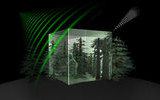What in situ and lidar measurements are needed for BIOMASS training & validation? What changes are needed to current networks? And how good are current networks anyway for representing biomass at the large scale? (1)
2015-01-27 15:30 - 2015-01-27 17:10
Chair: Jerome Chave, CNRS / Keryn Paul, CSIRO
-
15:50 Local spatial structure of forest biomass and its consequences for the calibration strategy of the BIOMASS Mission
Réjou-Méchain, Maxime (1,2); Muller-Landau, Helene (3); Chave, Jérôme (1) 1: Laboratoire Evolution et Diversité Biologique, UMR 5174 CNRS, Université Paul Sabatier, 31062 Toulouse, France.; 2: Institut Français de Pondichéry, India; 3: Smithsonian Tropical Resource Institute, Apartado Postal 0843-03092 Balboa, Ancon, Panama.
Show abstract
Forest carbon mapping has the potential to greatly reduce uncertainties in the global carbon budget and to facilitate effective emissions mitigation strategies such as REDD+. Producing accurate global maps of forest biomass stocks is the primary objective of BIOMASS, the next European Space Agency (ESA) Earth Explorer Core Mission. However, the accuracy of these global forest biomass maps will depend critically on the quality of field measurements and calibration procedures. In particular, the BIOMASS products will probably be calibrated at a 4-ha resolution, an area larger than most of field inventory plots currently available. The mismatch in spatial scales between these plots and the larger pixels of the planned BIOMASS products is of particular concern, as it has the potential to introduce errors, especially if forest biomass shows strong local spatial variation. Here, we used 30 large (8-50 ha) globally distributed permanent forest plots to quantify the spatial variability in aboveground biomass density (AGBD in Mg.ha-1) at spatial scales ranging from 5 to 250 m (0.025-6.25 ha), and to evaluate the implications of this variability for calibrating remote sensing products using simulated remote sensing footprints similar to that planned in the BIOMASS mission. We found large local spatial variability in AGBD for standard plot sizes, averaging 46.3% for replicate 0.1 ha subplots within a single large plot, and 16.6% for 1 ha subplots. AGBD showed weak spatial autocorrelation at distances of 20-400 m, with autocorrelation higher in sites with higher topographic variability and statistically significant in half of the sites. We further show that when field calibration plots are smaller than the remote sensing pixels, the high local spatial variability in AGBD leads to a substantial “dilution” bias in calibration parameters, a bias that cannot be removed with standard statistical methods. Our results suggest that topography should be explicitly accounted for in future BIOMASS sampling strategies and that care must be taken in designing calibration schemes if the BIOMASS mission is to achieve its promise.
-
16:10 New measurements of biomass and structure in tropical forests
Disney, Mathias Inguar (1); Burt, Andrew (1); Calders, Kim (2); Cuni-Sanchez, Aida (1); Avitabile, Valerio (2); Lewis, Simon (1); Gonzalez de Tanago, Jose (2); Herold, Martin (2); Raumonen, Pasi (3); Lewis, Philip (1) 1: Dept. of Geography, University College London, United Kingdom; 2: Laboratory of Geo-Information Science and Remote Sensing, Wageningen University, Netherlands; 3: Department of Mathematics, Tampere University of Technology, Finland
Show abstract
We present results from combining new terrestrial laser scanner measurements and 3D reconstruction tools, to provide rapid, non-destructive measurements of 3D tree structure and volume in tropical forests. We have deployed the method in a number of 1ha sampling plots in Gabon, W. Africa, Queensland, Australia and the Brazilian Amazon. The resulting quantitative structural models (QSMs) of tree structure are topologically complete descriptions of tree volume, and with wood density, were used to estimate above ground biomass (AGB) of 1000s of trees ranging in size from a few cm to > 2m diameter-at-breast height (dbh). Crucially, the resulting AGB estimates are independent of allometric equations which underpin all current estimates of tropical forest biomass. These equations contain very few trees of dbh > 100 cm and consequently, uncertainty in AGB as predicted by the models tends to grow with dbh. We have shown through destructive harvest measurements that the errors in lidar-derived AGB are independent of diameter. In addition, the ground-based lidar data provide very accurate tree height, crown extent and vertical foliar profile measurements. These measurements can all be used to validate existing allometric estimates of AGB to assess their uncertainties independently. In addition, the resulting 3D QSMs provide additional non-destructive data with which to augment and update allometric relationships. This has the potential to rapidly expand the number and size-range of trees on which such relationships are based. This is likely to prove important for missions such as BIOMASS, which will rely to an extent on the accuracy of allometric relationships between height in particular and biomass. In addition, crown extent and height in particular may be used to develop new allometric relationships that do not rely on dbh, which is not available from remote sensing measurements. We also show how the lidar-derived QSMs can be used to test metabolic scaling theories which hypothesise invariant relationships between size and metabolism, at the tree and stand level. These hypotheses, while interesting, are currently very difficult to test due to their requirement for comprehensive branch size and distribution measurements; such measurements are extremely hard to make in practice. Lastly, we show how the QSMs derived from the lidar scanner data can be used to parameterise and drive radiative transfer models for EO applications. We can either use the structure directly, in fully 3D optical EO models for example, or for parameterising RADAR models which require some simplified representation of structure in particular. We use the measured 3D structure to estimate the impact of this type of simplification.
-
15:30 A Ground-up View on Measuring Tropical Forest Biomass
Phillips, Oliver University of Leeds, United Kingdom
Show abstract
The task we face of mapping of the distribution of carbon across the world’s forests is primarily a tropical task, because at least more than 70% of forest biomass is here. Fieldwork is critical to validating and improving satellite observations. This is a highly labour-intensive process whose challenges are rarely technological and hence, perhaps, easily underestimated. The purpose of my talk is to illustrate the practical nature of the tropical field challenge and how a ground-up view may contribute. Thus, using examples from personal experience and the recent literature, I will: (1) reveal what ecologists and botanists actually get up to in their plots; (2) discuss some hard-won lessons about what factors control natural variation in tropical forest biomass.”
-
16:20 Plenary Discussion - BIOMASS
Show abstract
Plenary Discussion - BIOMASS
-
17:00 Summary Report “What in situ and lidar measurements are needed for BIOMASS training & validation? What changes are needed to current networks? And how good are current networks anyway for representing biomass at the large scale”
Show abstract
Summary Report “What in situ and lidar measurements are needed for BIOMASS training & validation? What changes are needed to current networks? And how good are current networks anyway for representing biomass at the large scale”
 In May 2013, the Biomass mission concept was selected to become the next in the series of satellites developed to further our understanding of Earth.
In May 2013, the Biomass mission concept was selected to become the next in the series of satellites developed to further our understanding of Earth.
 REPLAY EARTH EXPLORER 7 USER CONSULTATION MEETING (PART 1)
REPLAY EARTH EXPLORER 7 USER CONSULTATION MEETING (PART 1)
 POLinSAR 2013 Workshop
POLinSAR 2013 Workshop